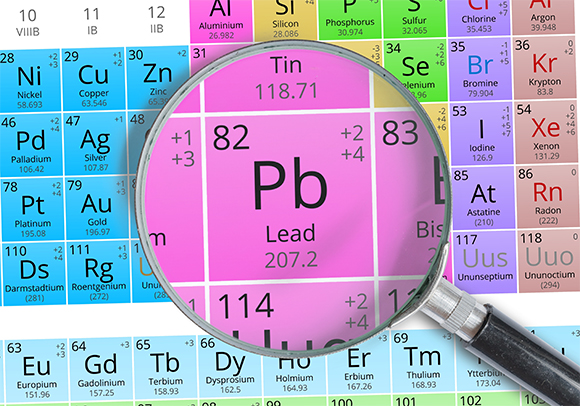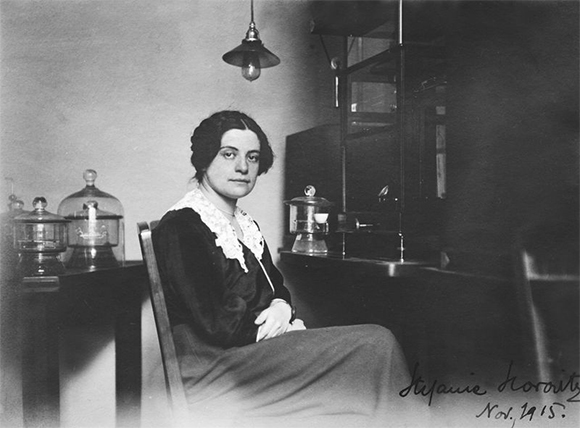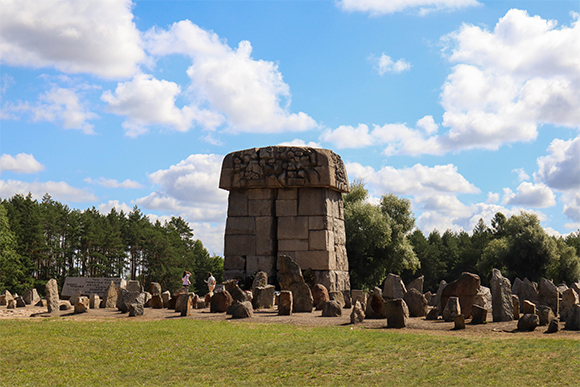In the early years of the age of radioactivity, the pioneering work of a young Jewish scientist contributed to the discovery of isotopes. Less than thirty years later, during the Holocaust, Stephanie Horowitz was sent to her death in the gas chambers at Treblinka.
In the early years of the twentieth century, the phenomenon of radioactivity still raised more questions than answers. The groundbreaking research of Marie Curie and her husband Pierre showed that certain elements, such as radium, emit strong radiation. But how do they do it?
In 1901, the British chemist Frederick Soddy, who worked in Canada with Ernest Rutherford, discovered that during the process of radioactivity, a heavy atom decays and transforms into a different atom. As he further investigated this phenomenon, Soddy uncovered the principles behind this decay, now known as the Soddy-Fajans Displacement Law, named after both Soddy and Polish physical chemist Kazimierz Fajans, who independently discovered it around the same time. In one of the identified pathways, uranium (element 92 in the periodic table) initially decays into thorium (element 90), which subsequently disintegrates into radium (element 88), then into radon (86), polonium (84), and into lead (82). Rutherford demonstrated that this decay is caused by the emission of a helium nucleus, consisting of two protons and two neutrons, from the nucleus of the original atom.
Based on this sequence, Soddy and his colleagues calculated that the atomic weight of lead should be 206 units. However, this calculation did not match the known weight of lead, which is actually 207.19 units, corresponding to the weight of 207.19 protons or neutrons. Given that the nucleus of a lead atom always contains 82 protons, its atomic number, the discrepancy in weight predictions suggested, for the first time, the existence of isotopes. Isotopes are distinct forms of the same element that differ only in atomic weight, since they have a different number of neutrons in the nucleus.
To test the theory, scientists had to obtain a sufficient quantity of pure lead from uranium ores followed by careful measuring of its atomic weight. Both of these tasks were quite challenging with the scientific tools that were available over a century ago.
At the time, the leading expert in analytical chemistry and atomic weight determination was Theodore W. Richards of Harvard University in the United States, who received the 1914 Nobel Prize in Chemistry for his work in the field. Europe’s foremost expert was Otto Hönigschmid, a student of Richards, who held a research position at the Prague Polytechnic University and was also involved in research at the Institute for Radium Research in Vienna. In addition to Hönigschmid's expertise, the Austrian institute had another advantage: easy access to radioactive uranium and thorium ores from mines near the Czech border. Consequently, Soddy and Fajans asked Hönigschmid to try to determine the atomic weight of lead in radioactive ores.

Lead has 82 protons in its nucleus, which defines its atomic number. The number of neutrons in a lead atom can vary leading to the formation of different isotopes of lead with different atomic masses. | Image: vchal, Shutterstock.
Stephanie Horowitz (or Stefania Horovitz), was born in Warsaw on April 17, 1887. Her father, Leopold, was a skilled portrait painter renowned for his Baroque-style works. Little is known about her mother, Rosa, née London. When Stephanie was three years old, her family moved to Vienna. In 1907, she enrolled in the University of Vienna to study chemistry, and by 1914, she had completed her doctoral studies in the field.
During her doctoral studies, Horowitz became acquainted with Lise Meitner, a notable physicist who would later play a pivotal role in the discovery of nuclear fission and even have a chemical element named after her. Like Horowitz, Meitner was of Jewish heritage, and despite converting to Christianity later on, she faced persecution by the Nazis and was ultimately forced to flee from Berlin to Stockholm.
Meitner's friendship with Hönigschmid would prove instrumental in Horowitz's career. When Hönigschmid mentioned to Meitner that he was looking for a young researcher to determine the atomic weight of lead, she recommended Horowitz. This led to Horowitz's hiring at the end of 1913, even before she had officially completed her doctorate.The laboratory received tens of kilograms of uranium ore, from which the radium was isolated and sent to laboratories in other countries, including those of Rutherford and Marie Curie. Horowitz was then tasked with the challenging and physically exhausting job of producing lead from the remaining material. Several months later, Hongschmid reported in a letter to Meitner - "Miss Horowitz and I have been working like black laborers. It is Sunday, the weather is wonderful, and we are still sitting in the laboratory after six in the evening.”
The reason for the grueling work was the long and complex chain of processes required to isolate lead as pure as possible. The process included a reaction of the lead with chlorine to produce chloride, multiple washings, filtrations, dissolution of the lead in sulfuric acid, consolidation, repeating the washing and filtrations. This was followed by, dissolving the lead in nitric acid, consolidation, and repeating the dissolution and formation process five more times. The lead was then dissolved in hydrochloric acid, followed by a series of additional stages of dissolution and consolidation. Finally, nine additional stages of dissolution and consolidation had to be performed to obtain lead chloride (PbCl2) that was pure enough to measure its atomic weight.

Stephanie Horowitz: Pioneering and grueling work at the forefront of science. Photo: Public Domain, Wikimedia Commons.
The hard work paid off in the end. Horowitz discovered that the atomic weight of the lead from the uranium ore was 206.736 units - not the 206 units that Soddy had predicted, but significantly different from the known atomic weight of lead, which was 207.19. This difference indicated the existence of isotopes, meaning that the lead Horowitz isolated contained a certain amount of lead 206, which has 124 neutrons and 82 protons in its nucleus, as well as heavier lead isotopes such as lead 208, and possibly other isotopes.
Today, we know that more than half of the naturally occurring lead is made up of lead-208, while approximately a quarter of the lead atoms are lead-206. However, there are also significant amounts of lead-207 and lead-204 isotopes present. The relative proportions of each isotope in a given sample determine the overall atomic weight of the lead in that sample.
Hönigschmid and Horowitz published their findings in a joint paper in 1914, which had a significant impact on the scientific community as it provided the first evidence confirming the existence of isotopes, as Soddy had predicted. In a review published in 1968, this paper was selected as one of the most important papers in chemistry in the first half of the twentieth century. They later applied their method to additional samples of uranium ore obtained from mines in Africa and Norway, and arrived at an atomic weight of 206.046, which was very close to Soddy’s prediction, given the limitations of the measurement methods at the time.
At the same time as their successful work with lead, Hönigschmid and Horowitz embarked on another project - measuring the atomic weight of the newly discovered element, Ionium, found in 1907. Horowitz's meticulous measurements revealed an unexpected finding: Ionium was not a new element at all, but actually an isotope of thorium, an element with the atomic number of 90. This discovery, published in a joint paper in 1916, not only helped chemists to organize the periodic table but also provided additional evidence for the existence of isotopes in other elements. Today, we know that many elements have isotopes, and their significance to science is enormous.
A few years later, in 1921, Soddy was awarded the Nobel Prize in Chemistry ‘for his contributions to our knowledge of the chemistry of radioactive substances, and his investigations into the origin and nature of isotopes’. In his Nobel lecture, he acknowledged the importance of the work of Hönigschmid and Horowitz to the field.
From Chemistry to Psychology
After World War I, Hönigschmid decided to leave Vienna and accept a prestigious position at the University of Munich, which marked the end of his fruitful collaboration with Horowitz. The reasons behind their separation remain unclear. One possible explanation could be the University of Munich's policy against hiring women at the time, which may have prevented Hönigschmid from offering Horowitz a position. Alternatively, he may have chosen not to continue working with her, or she may have decided to part ways with him. Some reports suggest that family matters, possibly the loss of both of her parents during the war, could have contributed to Horowitz's decision not to continue her scientific career.
It is also possible that Horowitz chose to shift away from the field of chemistry on her own accord. Following her separation from Hönigschmid, she began to take a keen interest in psychology and began working as an educational consultant. Later on, she partnered with the Austrian psychologist Alice Friedmann and together they established a therapeutic center for children that offered psychological treatment in a safe environment. The center operated until 1934 when it was shut down by the fascist Austrian government.
Very little is known about Horowitz's life after leaving Vienna. It is known that in 1937, at the age of 50, she moved to live with her sister Sophia, who was married and resided in or near Warsaw. In 1939, Nazi Germany occupied Poland, and the following year, Jews in Warsaw were forced into the ghetto, along with thousands of others who were forcibly deported there from various places. Life in the ghetto was characterized by severe hunger, diseases, and Nazi brutality towards Jews, but it is likely that the sisters managed to survive. In 1942, when the deportation of Jews from the ghetto began, the sisters lined up as required at the Warsaw Umschlagplatz, presumably out of fear of endangering others if they tried to escape. According to the testimony of her nephew, the two were sent to the Treblinka extermination camp, where they were murdered in the gas chambers.

The remains of the Treblinka extermination camp where Horowitz was murdered along with another 900,000 Jews, | Photo by Guy Eliraz/Shutterstock
Hönigschmid’s research in Munich continued to focus on measuring the atomic weight of elements and identifying additional isotopes, with his publications on the subject continuing until 1941. It is unclear what scientific work he pursued during World War II, but there is little doubt that he was aware of Horowitz's death. Reports from the Polish chemist Kazimierz Fajans suggest that Horowitz had returned to Warsaw to be with her sister and that both had been murdered by the Nazis. Those who were acquainted with Horowitz within the scientific community were likely informed of her tragic fate. It is possible that this knowledge played a role in Hönigschmid’s decision to end his own life, along with his wife, shortly after the war, in October 1945.
A year after Hönigschmid’s death, a lengthy obituary was published in the scientific journal Nature, detailing his significant contributions to science. However, the article made no mention of Horowitz or her work. Despite Hönigschmid’s efforts to acknowledge her contributions to their joint work, appearing side by side in published articles, belittlement and discrimination against female scientists were widespread in those days, especially so against women in junior positions, with their contributions often being erased. Horowitz's work was dismissed as nonexistent. It was only in recent years that some publications finally did justice to the memory of this Jewish chemist, whose early work stood at the forefront of global research.
Stephanie Horowitz was among the 900,000 Jews murdered in Treblinka. In the face of this unimaginable horror, the belated recognition of the importance of her work as a researcher who proved the existence of isotopes is a small victory of humanity over evil.
